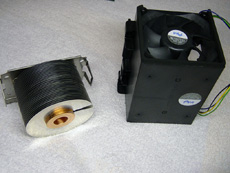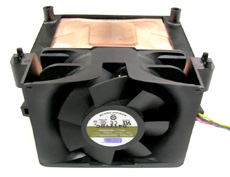Intel's Long Awaited BTX Form Factor
by Purav Sanghani on November 15, 2004 5:31 AM EST- Posted in
- Cases/Cooling/PSUs
BTX Cooling and Airflow
Again, the main reasoning behind Intel during the redesign of the ATX form factor was to design a more efficient cooling solution. As components are built faster they also run hotter. The ATX form factor improved on the AT specifications by placing the CPU closer to the back of the case where fans could be mounted as exhausts to pull hot air from the CPU out of the chassis and away from other components. Now that those other components in PCs are beginning to expand in performance and functionality they are running at temperatures as high as that of CPUs so a new design needed to be devised to help cool these components in a more efficient manner than just slapping more fans in a standard case. Now, we have come full circle with the CPU moving back towards the front of the case. Since Intel has the standards on PCIe very heavily controlled, worrying about PCIe cards extending too far to the front of the case should not be a problem.Intel implements a more efficient passive cooling system by placing the majority of components inline with the CPU towards the rear of the chasis.
 Click to Enlarge |
 Click to Enlarge |
The most important piece of hardware when it comes to cooling is the CPU heat sink fan. Without this a CPU would not POST, and would most likely damage the hardware. Intel has included what it calls a "BTX Thermal Module" which consist of either a spiral or stacked-fin heatsink and a fan which is mounted at the end of a plastic duct, facing the front end of the case. Intel has not limited this hardware to only one type though. In their virtual press kit Intel speaks of Type I (Standard height) and Type II (Low profile) thermal modules. The Type I module will be designed for a broader range of cases from small form factor to the larger full tower applications while the Type II module will be designed specifically for the ultra-small form factor designs.
 Click to Enlarge |
 Click to Enlarge |
Intel also mentioned that along with those two types of thermal modules there will be variations in the units for processors rated at different Thermal Design Power, or TDP levels. The difference in modules will exist mainly with the heatsink, with slight variations in the duct. The fan will, however, remain the same within the same type (Type I/Type II) of module.
This thermal module was the only piece of cooling hardware aside from the power supply which we found to be surprising. We couldn't imagine running an ATX case with only one CPU heatsink fan and we have our doubts about Intel's single module design, but we will leave that to our benchmarks to decide.










77 Comments
View All Comments
HardwareD00d - Monday, November 15, 2004 - link
Instead of spending all the money to research BTX, Intel should have just made watercooling standard on the Prescott CPU. Apple could have said they stole the idea from them like everything else ;)Omega215D - Monday, November 15, 2004 - link
It looks like Intel needs all the cooling it can get. I found an interesting article at Toms Hardware and here;s the closer about its heat problem "So, should a vendor release a product that is only able to run at its maximum performance under special circumstances? The fastest processors certainly are very exclusive devices, but that should not cause more troubles than necessary. The customer wants products that simply work! Think about that before releasing faster products, Intel." All I can say is wow, because I can remember my P3 866 didn't need all that cooling though now I moved on to AMD.HardwareD00d - Monday, November 15, 2004 - link
It sounds like you can essentially get the same thermal performance from an ATX case by adding 1 additional case fan.At least Intel has decided not to push this new form factor down peoples throats. Honestly, that's what I figured they'd try to do.
Gatak - Monday, November 15, 2004 - link
To have the powersupply and drive bays at the bottom is a good thing. It will keep the temperature more balanced inside the case and also provide more room at the top for cards and for exhaust fans, rather than craming everything up there.Pythias - Monday, November 15, 2004 - link
ROFL #6!!Ecmaster76 - Monday, November 15, 2004 - link
If a retail board showed up to a review with that horrible a component layout, it would be figuratively flogged.I find that the review was somewhat flawed since it failed to see what would happen with a discrete graphics card in the box. If one was used, I didn't spot it in the screenshot of the full ATX or uBTX screeshots, and it wasn't mentioned in the text.
Finally it should be mentioned that many people have theorized that the BTX layout would not work well for the Athlon64's onboard memory controller because of issues with trace layout. I'm no expert, but it does look like it might get a little tight.
ksherman - Monday, November 15, 2004 - link
"Anand's *vacation* work trip to Taipei..."Probably one of the funniest things i have read in one of your reviews.... ;)
raskren - Monday, November 15, 2004 - link
As always, so much Intel backlash, simply because, its Intel.This is how cases should have been done originally. Align all the hot components and put a fan in front and behind them. Makes sense, right?
Current ATX design is "put a fan on every hot item you have". At least that's how my case is.
LoneWolf15 - Monday, November 15, 2004 - link
To me, BTX looks like a winner for only one niche: small form factor business desktops. By that definition, I don't include Shuttle's wonderful SFF PC's which work best for home and HTPC enthusiasts. The microBTX form factor looks great for an office environment where quiet operation is a real plus, as well as power consumption, and since business PC's don't need to be cutting-edge, middle-end processors can be used that don't generate a lot of heat.Tor the enthusiast however, BTX looks like a bust to me, more of an attempt by Intel to throw the market out of whack, specifically AMD's market. Enthusiasts already have case designs meant to exhaust a lot of air and keep systems cool. Many enthusiasts LIKE a little bit larger case so that they have more expansion room, with the exception of their HTPC, and so that they can house a decent power supply for that expansion.
I see HP, Compaq, IBM, and other mainstream business computing giants adopting BTX; it will probably do well in the business market as well as in mass retail, where OEMs would rather make a system with less fans to fail and at cheaper cost. That's a pretty big sector for profit of course, but this form factor, IMO, leaves PC enthusiasts out in the cold.
Beenthere - Monday, November 15, 2004 - link
BTX is obviously NOT a great design. Intel changes sockets, Mobo and other specs periodically to FORCE people to update to their latest crap. Don't expect a rush to BTX. It's another Intel spec unlikely to ever gain foothold...For those who don't already know you can do wonders for ATX case cooling with "managed airflow". By actually directing incoming cool air to the heat sources and isolating the CPU fan from warm air in the case, no one really needs a BTX case and your PC will run much cooler with managed airflow.
While Intel definitely needs a tornado inside a box to cool their defective 90 nano CPUs, the BTX standard is just another Intel marketing scam for all practical purposes.
Just say NO !